-Zero scope as usual.
-Loosen set screws.
-Slip turrets back to zero.
-Tighten set screws.
Yeap not rocket science classic two screw design

Follow along with the video below to see how to install our site as a web app on your home screen.
Note: This feature may not be available in some browsers.
-Zero scope as usual.
-Loosen set screws.
-Slip turrets back to zero.
-Tighten set screws.
Caveat to that: be sure the turret is in the locked position before you loosen the screws.Yeap not rocket science classic two screw design
I'll have mine this week or so, thanks for that. Just getting it in my mindCaveat to that: be sure the turret is in the locked position before you loosen the screws.
Optics Planet. They showed it at a certain price lower than usual while I was browsing on my phone, then sent me a discount code of 10% to allow them to spam me with text messages. So I sent them my cell number to allow spam. So the low price is on my phone, and later in the day I look on my computer and could not see that low price. But my phone still shows it.Wow! What a great deal. Could you please share where you got it for that price?
So a little over $2200 to your door, not bad at allOptics Planet. They showed it at a certain price lower than usual while I was browsing on my phone, then sent me a discount code of 10% to allow them to spam me with text messages. So I sent them my cell number to allow spam. So the low price is on my phone, and later in the day I look on my computer and could not see that low price. But my phone still shows it.
Hmmm . . . I discussed it with the wife (who knows I have been wanting to get into longer range shooting) and went back to my phone. The price was still there, so I added it to my cart . . . hmmm . . . still shows that price. Put in the payment info . . . added the 10% coupon code . . . it dropped 10% of off the already three hundred bucks or so lower price . . . free shipping, BOOM. It is on its way.
Maybe the devil did it because I was looking at scopes on my phone instead of paying attention to the sermon
Oh, $2119 to my door, which includes my state's sales tax. $1907 w/o sales tax (I figured that would be more relevant, since every state is different on sales taxes and some states do not even have a sales tax). Shipping was free (included).So a little over $2200 to your door, not bad at all
Meh... Not required but can be helpfulCaveat to that: be sure the turret is in the locked position before you loosen the screws.
Haven't tried it either way yet, still waiting on my chassis to arrive. Just passing on what the Steiner rep at the PRE told me.Meh... Not required but can be helpful
MSR2? Dibs if you decide to sell.And... for reasons now I have a 3-18 in the house. There's a non-zero chance that I'll end up with all three of these, even if temporarily.
View attachment 8042846
The comparison to Hensoldt is greatly appreciated, I've been waiting for someone to do just that. For the price I do not expect the 3-18x56 to be the optical peer to the Henny, but I was hoping it would be like you mention above - "very good". I am excited to get mine.I posted most of this elsewhere for someone looking for a 3-18 scope but thought I should add my thoughts here since it is the official Steiner T6Xi thread.
The Steiner T6Xi 3-18x56 is a very impressive optic for the price. The more I use it, the more I like it. Last night I was using the Steiner in rotation with my Hensoldt 3-12x56 and 4-16x56 in low light and with a clip-on. The low light and general optical performance is very good. The lit MSR2 reticle is nice. The turrets are maybe my all around favorite, and I have NF and ZCO. I really like the feel, mils/rotation, that they are easily lockable, and the windows that change numbers are really slick. In use, the total experience feels much closer to my ZCO 420 and further away from my NF NXS 2.5-10x42, for what that is worth. It is overall a well thought out and nicely executed scope that is made in the USA, good job Steiner.
I paid for this out of my own pocket and have no ties to Steiner... or anyone for that matter. I hope this helps if someone is looking for more feedback.
Dude! Eat those banana already, sheesh."Steiner T6xi 5-30 with a 56mm objective and the SCR2-MIL reticle"(which is what I told my kindergartner when he asked all wide eyed), and my wife said I sounded like that kid from A Christmas Story (read what I said out loud, and, well, it does sound like that).
View attachment 8046533
Video showing the Never-Lost turrets on the Steiner T6Xi 3-18x56 scope.
How’s the Steiner T6xi compares to the Trijicon Credo 1-6? They seem very similar on paper.
The wife brought a new bunch home, bright yellow. I threw the old ones in a blender with protein powder and chocolate milk and drank them!Dude! Eat those banana already, sheesh.
I have really been wanting to see one of these to see how they compare to the Colorado built XTR3's.
Any chance you could post some through-the-scope pics to show the reticle at varying magnifications?I liked my 1-6 so much that I got one of the T6Xi 2.5-15x50mm , FFP SCR.
Any chance you could post some through-the-scope pics to show the reticle at varying magnifications?
It does seem off, why a 2.5-15x50 that is only a couple ounces lighter than a 3-18x56? At 25oz (maybe even 27oz) a 2.5-15 appeals but at over 30, no thanks, not for me.Can anyone verify the weight first hand? Looking at factory specs there is only 2.5oz difference between the three. Seems off
318 rocksSo your 5-30 weighs what the 2-15 is supposed to. I’ll probably order up a 3-18
Does it come with caps?On the flip side of that, the sun shade that comes free with the T6Xi fits the ZP-5 as well.
Yes it comes with Tenebraex covers front and rear.Does it come with caps?
Awesome, Saturday can't come soon enough.Yes it comes with Tenebraex covers front and rear.
I'll be honest, I couldn't really see the illumination until about 7 or 8. However, that was with the overhead light on.Hey guys really appreciate all the info on this thread. Can someone post pics of the msr2 and the scr2 while illuminated at the lower end of the magnification? Just trying to decide between the two at reticles at this point.
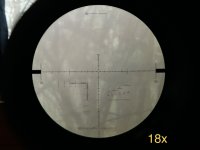
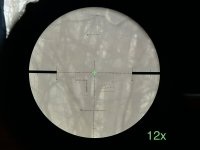
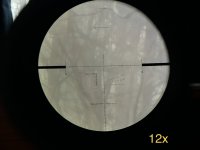
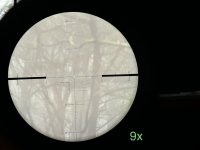
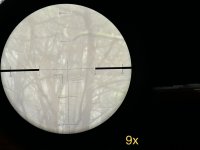
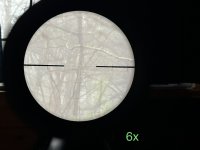
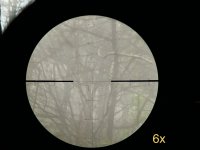
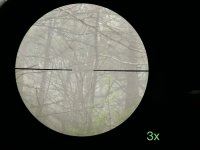
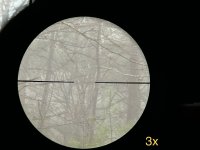
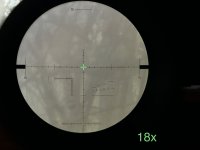
I think you’ll like it, my first impressions are that it’s a solid overall package with a nice form factor to boot. From my short time behind the Leupold 3.6-18, I prefer the Steiner. However, I have not yet had the chance to verify its repeatability. I’ve got three tenths below the zero stop and 22.8 mils of elevation adjustment with a 20 MOA base btw.
